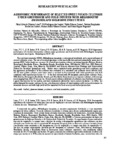Please use this identifier to cite or link to this item:
http://www.alice.cnptia.embrapa.br/alice/handle/doc/1055068| Title: | Agronomic performance of selected sweet potato cultivars under greenhouse and field infested with meloidogyne incognita and soilborne insect pests. |
| Authors: | LIMA, F. S. de O.  SANTOS, G. R. dos   CORREA, V. R.   SANTOS, P. R. R. dos   CORREIA, M. A. R.   NOGUEIRA, S. R.   |
| Affiliation: | Fábia Silva de Oliveira Lima, Instituto Federal de Educação, Ciência e Tecnologia do Tocantins-Campus Dianópolis; Gil Rodrigues dos Santos, Universidade Federal do Tocantins-Campus Gurupi; Valdir Ribeiro Correa, Instituto Federal de Educação, Ciência e Tecnologia do Tocantins-Campus Dianópolis; Patrícia Resplandes Rocha dos Santos, Universidade Federal do Tocantins-Campus Gurupi; Marcus André Ribeiro Correia, Instituto Federal de Educação, Ciência e Tecnologia do Tocantins-Campus Araguatins; SONIA REGINA NOGUEIRA, CPAF-Acre. |
| Date Issued: | 2016 |
| Citation: | Nematropica, Florida, v. 46, n. 1, p. 97-105, 2016. |
| Description: | The root knot nematode (RKN), Meloidogyne incognita, is widespread worldwide and a major pathogen of several cultivated crops. The use of resistant genotypes is the most effective and environmentally sound way to manage RKN. In this study, we screened 16 selected sweet potato cultivars including Amanda, Bárbara, Beatriz, Beauregard, Brazlândia Branca, Brazlândia Rosada, Brazlândia Roxa, BRS Amélia, BRS Cuia, BRS Rubissol, Carolina Vitória, Duda, Júlia, Marcela, PA-26/2009, and Princesa obtained from Embrapa and Universidade Federal do Tocantins? germplasm bank. Studies were conducted under greenhouse and field conditions and the agronomic performance of the cultivars was evaluated in a nematode and soilborne insect-infested field. All 16 sweet potato cultivars tested were rated as resistant to this nematode both under greenhouse and field conditions with reproduction factors < 1. In the field infested with M. incognita, sweet potato cultivars Duda, BRS Amélia, Beauregard, Brazlândia Rosada, and Brazlândia Roxa stood out as superior cultivars, with average yield ranging from 26 to 47 tons per ha. Overall, most cultivars exhibited a fusiform to near fusiform root shape, a good characteristic for the market, and were moderately affected by insects (attack incidence 1 to 30%). As global demand for energy continues to rise, selecting new cultivars of sweet potatoes with increased resistance to nematode diseases and with high yield will be important for food security and biofuel production. |
| Thesagro: | Praga de planta Helminto Nematóide Meloidogyne incognita Batata doce Ipomoea Batatas Estufa Performance Variedade resistente |
| NAL Thesaurus: | Plant pests Plant parasitic nematodes Sweet potatoes Root-knot nematodes Greenhouse production Crop yield |
| Keywords: | Batatas Rendimiento de los cultivos Cultivos de invernadero Nematodo de la raíz Nemátodo parasitario de las plantas Plagas de plantas |
| ISSN: | 2220-5616 |
| Type of Material: | Artigo de periódico |
| Access: | openAccess |
| Appears in Collections: | Artigo em periódico indexado (CPAF-AC)  |










